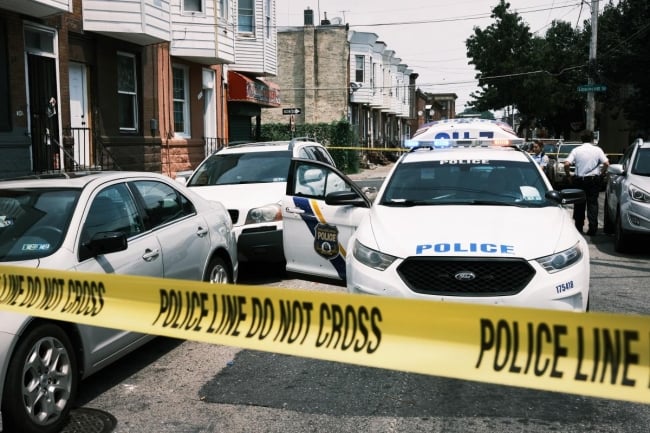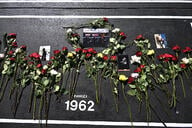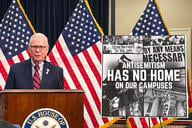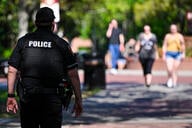You have /5 articles left.
Sign up for a free account or log in.

Concerned by gun violence in Philadelphia, Temple University is looking to double its campus police force.
Spencer Platt via Getty Images News
When Temple University administrators pledged in November to hire more police officers and double neighborhood patrols around the university, it came as welcome news to campus law enforcement. But now the Temple University Police Association claims the administration hasn’t delivered on those promises.
The Temple University Police Association (TUPA), a new union representing campus law enforcement, has been vocal about its recent differences with administrators, accusing leadership of presenting “factually untrue” information on hiring and increased patrol numbers.
This disagreement comes amid active negotiations between the university and the union, set against a backdrop of recent gun violence that has alarmed students and parents. In November 2021, Temple student Samuel Collington was killed in a botched robbery in a neighborhood near campus. A string of recent shootings in neighborhoods heavily populated with students has exacerbated fear in Philadelphia, which counted more than 120 homicides in 2021.
Temple’s executive director of public safety stepped down last month after nearly 40 years at the university.
What Officers Want
Temple president Jason Wingard announced plans last winter to increase the “Campus Safety force” by 50 percent. But that effort has been slow going, said Alec Shaffer, president of TUPA. While the university plans to add more police officers to bring the total number to over 100, Shaffer said the current number stands at approximately 60.
Last month Ken Kaiser, Temple’s senior vice president and chief operating officer, said, “The university has invested hundreds of thousands of dollars in overtime to ensure patrols meet or exceed all historic norms. Through the new officers that have been hired as well as the increased Philadelphia Police Department supplemental patrols, the university has more than doubled the number of officers actively patrolling the patrol zone at any given time.”
But Shaffer said the numbers just don’t add up. Given that several officers have left since November and the hiring process is crawling along, he questions Kaiser’s claim.
“I don’t know where he's getting that number from when, since November, we’re negative five police officers,” Shaffer said. “So I don’t know how they’re doubling patrols.”
Just how many officers Temple has is a matter of dispute. A statement from the university suggests that Shaffer is essentially stretching the truth amid ongoing negotiations.
“Temple University police and security officers provide outstanding service to the university and our community,” the statement from Temple said. “Their professionalism and dedication, under some of the most trying circumstances, cannot be overstated. However, the statement from their new union representative regarding patrol coverage creates unnecessary confusion.”
Temple counts “83 filled officer positions” and a vacancy rate of 23 percent. The university notes the count is up from 75 officers at the start of the school year, when the force had a vacancy rate of 31 percent.
“We previously budgeted for 108 officer positions, but as we have noted, we are hoping to greatly exceed that number, provided that we are able to find the right candidates for the positions,” the university said in a statement shared by Temple spokesperson Stephen Orbanek.
Shaffer suggests there are “60 active patrol officers” spread across three locations: the main campus in north Philadelphia, the Health Sciences campus and a site outside the city. Additionally, he said the department is currently operating at about 60 percent capacity.
“I think there is a lack of communication between the police department administration and the [public relations] side of the university,” Shaffer said. “But when you look at the numbers, I’m not sure where they’re getting those from. I’m not sure if they’re trying to include private security.”
Temple shed some light on the calculation in an email to Inside Higher Ed, noting that it draws from other law enforcement agencies to supplement safety efforts, which has allowed it to double patrol hours.
“Temple pays for patrol coverage beyond the tireless efforts of Temple’s police and security officers, including the Philadelphia Police Department, security officers from Allied Universal, and Bureau of Liquor Control Enforcement officers,” the email read. “Because the safety of our students and our community is our highest priority, Temple has dramatically increased its spending on these areas to increase the number of patrols. The university’s annual spending for 2022 is projected to be well over double that of last year which translates into more professional law enforcement and public safety presence in and around Temple. The university has also paid Philadelphia Police for additional officers, who together have increased the weekly patrol hours from 96 to 208, and we are already working with the city on further patrols to secure the safety of our community.”
Though he disagrees with Temple’s math, Shaffer welcomes the prospect of hiring more police officers. He said about 100 total are needed and that current officers have logged more than 20,000 hours of overtime—often mandated—since the start of the fiscal year in July. When counting other police staff, such as dispatchers, the overtime hours stretch to almost 30,000.
“There’s only so many 16-hour shifts you can work,” Shaffer said. “It drains morale.”
Hiring Challenges
Temple has stressed that it is actively recruiting police officers, but challenges persist.
“It is true that Temple’s Department of Public Safety, like most law enforcement employers, is facing challenges to fill open positions. That is an unfortunate reality of a workforce marketplace that has been impacted by increased violence, public perception of police, and the pandemic,” Orbanek said. “But to be clear, the number of patrols on and around campus has increased.”
However, Shaffer contends that Temple needs to make certain investments if it wants to meet its staffing goals—namely, improving pay and benefits as well as making more resources available to officers.
“It’s difficult to attract qualified candidates, because we just aren’t competitive when it comes to pay, working conditions or equipment when you try to compare that to other police departments or even other university police departments, unfortunately,” Shaffer said.
He added that Temple police officers need equipment such as load-bearing vests, which help evenly distribute the weight of their gear, and upgraded communications systems.
Temple isn’t alone in its struggles to attract qualified candidates to the campus police force. Recruiting challenges have hit law enforcement broadly in recent years, said Lewis Eakins, vice president for public safety and emergency preparedness at Ivy Tech Community College and a board member of the International Association of Campus Law Enforcement Administrators.
Eakins, who has conducted research on recruitment and retention challenges, notes the challenges are related not just to pay and benefits but also to a recent cultural shift.
“Times have changed,” Eakins said. “Based upon the shootings of African American males and the anti–law enforcement sentiment that is very prevalent right now, it’s not a career that people want to go into as much as they used to. Therefore, there is a shortage not just on college campuses, but in city police agencies, sheriff’s departments and even state police agencies.”
But when it comes to pay and benefits, colleges often can’t keep up with other police forces.
“What I’ve seen is that institutions of higher ed tend to pay less than municipalities where they are located, especially if it is an institution of higher ed in a major metropolitan area,” he said.
However, colleges do have one recruiting and retention advantage over other agencies: tuition benefits. Given the ever-increasing cost of higher education, Eakins suggests that free or reduced tuition—which Temple does offer employees—is one way that colleges can attract candidates who wish to earn a degree. Extending those benefits to spouses and dependents can also help with staffing, he said.
In his own experience managing campus police forces at multiple colleges, Eakins said he’s been able to retain employees for longer periods of time when free or reduced tuition is available to officers or their families.
Temple’s Public Safety Experts
Beyond its effort to hire more officers, Temple is addressing campus safety through a variety of new approaches.
The university announced in March that it would provide grants of up to $2,500 to landlords near campus to upgrade security at rental units. Funds can be used to install lighting or cameras. At the same time, Temple said it was exploring the formation of a neighborhood watch program.
Ongoing efforts to address gun violence include an audit of campus safety services; a nascent Task Force on Violence Reduction comprised of faculty, staff, students, parents and community members; and the introduction of the RAVE Temple Guardian personal safety app, which allows students to contact campus police and offers virtual safe walks, among other features.
Beyond Temple’s efforts, parents have also hired private security to patrol neighborhoods near campus where as many as 10,000 students live, according to The Philadelphia Inquirer.
Understanding Violence in Philadelphia
Dubbed the City of Brotherly Love, Philadelphia hasn’t lived up to its name in recent years, considering the rates of gun violence. City data for 2022 count “407 nonfatal and 108 fatal shooting victims” as of April 3, and a homicide rate on par with 2021.
Looking at data from January 2017 to June 2021, Caterina Roman, a criminal justice professor at Temple, and doctoral student Nicole J. Johnson found an uptick in gun violence in Philadelphia. And they noted one key but perhaps unsurprising takeaway: that gun violence occurred with more frequency in neighborhoods where illicit narcotics were easily bought and sold.
Another finding was that highly disadvantaged neighborhoods—those more likely to experience poverty and related challenges—did not see increased rates of gun violence during the COVID-19 pandemic. Those spikes were largely in neighborhoods that had open-air drug markets. And while neighborhoods around Temple are disadvantaged, there are no open-air drug markets, Roman emphasized.
“We can’t overgeneralize—‘oh, Temple is in a disadvantaged section of North Philadelphia, so it’s really bad there.’ I would say as a criminologist and scholar that those kinds of generalizations are not fully supported,” Roman said. “We did not find, post-pandemic, that neighborhoods with a high concentrated disadvantage had a quick uptick in gun violence.”
Ultimately, the two researchers suggest that solving gun violence in Philadelphia isn’t something the police can do but rather will require a community effort with broad buy-in and engagement.
“We need local government to partner with lots of different stakeholders and community residents to really think about how to tackle these complex problems,” Roman said. “And those problems in the drug-market neighborhoods might be a bit different than the problems along other places or corridors where there have been a few shootings around campus.”




